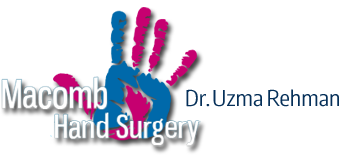How Hand Doctors Treat Ulnar Neuropathy
The ulnar nerve travels from the neck, all the way down through the arm to the hand. Ulnar neuropathy, also known as cubital tunnel syndrome, results when inflammation causes pressure on the ulnar nerve each time the elbow is bent, reducing the supply of blood to the nerve. This not only causes numbness, tingling or pain, but can also damage the nerve over time.
Symptoms of ulnar neuropathy include numbness, tingling or pain in the forearm and/or in the hand on the side of the little finger. Pain and numbness in the elbow may also be present. Decreased hand grip and/or the inability to pinch together the thumb and the little finger are also indications of Ulnar Neuropathy.
Ulnar Neuropathy Statistics
The American Academy of Orthopaedic Surgeons (AAOS) estimates that ulnar neuropathy affects approximately 1.8-5.9% of the general population. The AAOS indicates that ulnar neuropathy is more common in adults, particularly those engaged in manual labor or repetitive hand movements. And some studies suggest higher prevalence in men.
National Institute of Neurological Disorders and Stroke (NINDS) acknowledges ulnar neuropathy as a common peripheral neuropathy and emphasizes the increased risk in adults, particularly those with pre-existing conditions like diabetes or arthritis.
StatPearls, a leader in medical publishing, statistics and medical information and resources cites a study suggesting an incidence rate of 24.7 per 100,000 person-years for ulnar neuropathy at the elbow. They also suggest a potential male predominance, and a trend of higher prevalence in adults with occupational risk factors.
Who is at Risk for Ulnar Neuropathy?
Long-distance cyclists are particularly at risk for this condition, as are professional baseball pitchers. However, anyone whose activities result in intense and/or repeated jarring of the wrists and hands may be susceptible to ulnar neuropathy. This includes workers and hobbyists whose regular activities involve jarring blows to the hands and wrists – including operators of heavy machinery, tennis players, and more.
Hand doctors and athletes sometimes refer to ulnar neuropathy as “Handlebar Palsy” as a frequent cause is the repeated jarring of the wrists and hands when cycling. Repeatedly pitching a baseball can also be a likely cause of some more serious cases of this hand, arm and wrist condition.
How Hand Doctors Treat Ulnar Neuropathy Non-Invasively
Repetitious motions or constant jarring of the arm cause the inflammation of the ulnar nerve, so hand doctors begin by recommending patients reduce activities that repeatedly stress this area. Patients with the symptoms of ulnar neuropathy should take frequent breaks with arm stretching when they can. Bicyclists should wear padded gloves and move your hand position on the handlebars frequently.
Ice, rest and anti-inflammatory medications may help initially. However, anyone with the symptoms of ulnar neuropathy should always seeking the advice of a board certified hand doctor, as nerve damage can occur if the condition is not treated properly.
A hand doctor will review your symptoms, ask about your lifestyle and activities, and examine your neck, shoulder, elbow, arm and wrist. The hand doctor may also order tests such as a nerve conduction study (NCS) or an electromyogram (EMG).
EMG is a procedure where electrodes are placed into the muscles and on the skin to measure the health of muscles and the nerves that control them, to help the hand doctor identify the area of nerve damage and determine the severity of the condition.
Once the exact cause of the ulnar neuropathy is determined, the hand doctor will recommend behavioral changes that must be made to reduce the pressure on the nerve. Wrist splints may also be prescribed by your hand doctor to reduce discomfort. Oral anti-inflammatory medications and B vitamins may also be prescribed by your hand doctor.
How Hand Doctors Treat Ulnar Neuropathy with Surgery
Typically the above non- invasive measures will alleviate the condition. In more serious cases that do not respond, the hand doctor may recommend surgery. Most patients respond very favorably to surgery to correct this condition.
If the nerve is trapped in the elbow, the hand doctor may consider Cubital Tunnel Release surgery. This is typically done on an outpatient basis, and individuals can go home the same day. In this surgery, the area known as the cubital tunnel is cut to allow more room for the nerve to pass through.
As healing occurs, new tissue is formed and fills in this area. The recovery period for this type of surgery includes wearing a splint for a few weeks, followed by physical rehabilitation therapy (PT) to return full range of motion and strength to the arm and hand.
Top Wrist & Hand Doctor Bloomfield Hills
If you are experiencing hand, wrist or finger problems – including pain, numbness, stiffness or tingling – contact Bloomfield Hills board certified hand surgeon Doctor Rehman, for a comprehensive evaluation and consultation. As with most medical conditions, early detection, awareness, and a prevention or treatment plan is the most effective way to combat the effects of medical conditions including ulnar neuropathy.

